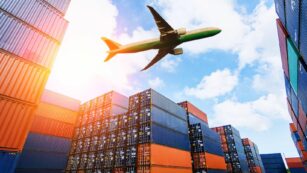Logistics and Transportation Software Development
- Importance of Software Development: Logistics and transportation software is essential for optimizing operations, reducing costs, and enhancing customer satisfaction.
- Key Features: The main features include route optimization, inventory management, and real-time tracking, all of which streamline supply chain processes.
- Technological Integration: Advanced technologies such as cloud computing, artificial intelligence, and IoT significantly enhance the functionality and efficiency of logistics software.
- Addressing Challenges: Key challenges include data security concerns and the integration of modern software with existing legacy systems, requiring effective strategies for successful implementation.
- Future Trends: Automation and sustainability are shaping the future of logistics software development, driving efficiency improvements and reducing environmental impact.
In today’s fast-paced world, logistics and transportation are more critical than ever. Companies face increasing pressure to streamline operations and enhance efficiency, making the development of specialized software a game-changer. With the right tools, businesses can optimize routes, manage inventory, and improve customer satisfaction, all while reducing costs.
Logistics and transportation software development isn’t just about creating applications; it’s about transforming how goods move from point A to point B. As technology evolves, so do the solutions available, offering innovative features like real-time tracking and data analytics. Embracing these advancements can give companies a competitive edge in a rapidly changing market.
Overview of Logistics and Transportation Software Development
 Logistics and transportation software development plays a crucial role in modern commerce. It encompasses various applications designed to enhance the efficiency and effectiveness of supply chain operations. Companies leverage this software to automate processes such as route optimization, inventory management, and shipment tracking.
Logistics and transportation software development plays a crucial role in modern commerce. It encompasses various applications designed to enhance the efficiency and effectiveness of supply chain operations. Companies leverage this software to automate processes such as route optimization, inventory management, and shipment tracking.
Key components of logistics software include:
- Route Optimization: Algorithms help identify the quickest and most cost-effective routes, reducing delivery times and fuel expenses.
- Inventory Management: Tools aid in tracking stock levels, forecasting demand, and minimizing excess inventory.
- Real-Time Tracking: Systems provide real-time visibility into shipment locations, enhancing communication and allowing for timely adjustments.
Emerging technologies such as artificial intelligence and machine learning drive further innovations in logistics software. AI analyzes data patterns, leading to improved demand forecasting and operational decision-making. Machine learning adapts processes based on new data, increasing system efficiency over time.
Data analytics represents another vital aspect of logistics software. By examining large datasets, companies gain insights into performance metrics, customer preferences, and market trends. This data-driven approach allows organizations to make informed decisions that align with business goals.
Overall, logistics and transportation software development significantly impacts operational success. By implementing these advanced solutions, companies can streamline their processes, improve customer satisfaction, and gain a competitive edge in the marketplace.
Key Features of Logistics and Transportation Software
Logistics and transportation software offers critical functionalities that drive efficiency and effectiveness in supply chain management. Key features include supply chain management, route optimization, and real-time tracking systems.
Supply Chain Management
Supply chain management features facilitate seamless coordination across all logistics functions. They improve inventory visibility, monitor stock levels, and manage order fulfillment processes. Integrated systems ensure that every team member accesses accurate data, enhancing collaboration and reducing errors. Advanced analytics tools allow companies to forecast demand and adapt strategies swiftly based on market fluctuations.
Route Optimization
Route optimization features employ algorithms to identify the fastest and most cost-effective delivery routes. These tools analyze factors like traffic patterns, weather conditions, and delivery windows to minimize travel time and fuel consumption. Dynamic routing capabilities enable companies to adjust plans in real time, accommodating last-minute changes and enhancing overall efficiency.
Real-Time Tracking
Real-time tracking features provide continuous visibility into shipment status and location. By using GPS and IoT technologies, companies can monitor their goods throughout the supply chain. Alerts notify stakeholders of delays or issues, allowing for immediate resolution. This transparency not only boosts customer satisfaction but also enables proactive decision-making to streamline operations.
Technologies Used in Software Development
Logistics and transportation software development relies on several advanced technologies that enhance functionality and efficiency. These technologies enable companies to solve complex logistics challenges and streamline their operations.
Cloud Computing
Cloud computing provides essential infrastructure for logistics software, offering scalable resources and cost-effective solutions. Companies access data storage, processing power, and software applications through the cloud, ensuring real-time accessibility and flexibility. This technology supports collaboration among stakeholders, enabling seamless communication and data sharing across platforms. By leveraging cloud-based logistics systems, businesses gain insights into inventory management, shipment tracking, and demand forecasting, all while reducing IT overhead.
Artificial Intelligence
Artificial intelligence (AI) enhances decision-making processes in logistics software development. AI algorithms analyze vast datasets to uncover patterns and trends, which improve demand forecasting and operational efficiencies. Machine learning techniques empower predictive analytics, enabling companies to anticipate customer needs and optimize inventory levels dynamically. By utilizing AI, logistics firms enhance route optimization and automate repetitive tasks, leading to reduced operational costs and enhanced customer satisfaction.
Internet of Things (IoT)
The Internet of Things (IoT) plays a pivotal role in modern logistics and transportation software. IoT devices, such as sensors and GPS trackers, collect real-time data on shipments, vehicle conditions, and environmental parameters. This connectivity provides unprecedented visibility into the supply chain, allowing for timely updates and proactive issue resolution. IoT technology enhances tracking accuracy, improves asset utilization, and supports data-driven decision-making, ultimately fostering a more responsive and efficient logistics environment.
Challenges in Logistics and Transportation Software Development
Logistics and transportation software development presents several challenges that companies must navigate to optimize their operations effectively.
Data Security Concerns
Data security stands as a significant challenge in logistics software development. Companies handle sensitive customer information, shipment details, and payment data. Ensuring the protection of this data from breaches and cyberattacks requires robust security measures. Adopting encryption protocols, implementing secure access controls, and conducting regular security audits become critical. In 2021, 30% of logistics companies reported data breaches, highlighting the need for enhanced security strategies.
Integration with Existing Systems
Integration with existing systems poses another obstacle in logistics software development. Many companies rely on legacy systems that may not be compatible with modern software solutions. Achieving seamless interoperability demands significant time and resources. Transitioning to new systems involves data migration, employee training, and possible downtime, which can disrupt operations. Approximately 50% of logistics firms face challenges integrating new software with their current infrastructure, emphasizing the need for careful planning and execution.
Future Trends in Logistics and Transportation Software Development
Emerging trends in logistics and transportation software development reflect the industry’s evolution toward enhanced efficiency and sustainability. Innovations such as automation, robotics, and sustainable practices are becoming integral to future systems.
Automation and Robotics
Automation and robotics are crucial for improving efficiency in logistics operations. Automated warehousing systems reduce manual labor through robots that handle sorting, packing, and shipping processes. Drones and autonomous vehicles streamline last-mile delivery, enhancing speed and lowering operational costs. Predictive analytics tools facilitate better resource allocation by forecasting demand and optimizing staffing levels.
labor through robots that handle sorting, packing, and shipping processes. Drones and autonomous vehicles streamline last-mile delivery, enhancing speed and lowering operational costs. Predictive analytics tools facilitate better resource allocation by forecasting demand and optimizing staffing levels.
Robotic process automation (RPA) is increasingly used for repetitive tasks like inventory management and order processing. RPA minimizes human error, increases accuracy, and frees up employees for higher-level tasks. As systems become more interconnected, automation will drive operational excellence across the supply chain.
Sustainability in Logistics
Sustainability in logistics focuses on reducing environmental impact while improving efficiency. Companies increasingly adopt eco-friendly practices, such as selecting sustainable transport options and utilizing energy-efficient technologies. Route optimization software decreases fuel consumption by identifying the most efficient delivery paths, reducing greenhouse gas emissions.
Furthermore, innovative materials and packaging solutions minimize waste. Many logistics software solutions incorporate carbon footprint tracking, allowing companies to measure and manage their environmental performance. Transitioning to greener logistics not only meets regulatory requirements but also caters to consumer demand for environmentally responsible practices, enhancing brand loyalty and competitive advantage.
Logistics and transportation software development is crucial for companies aiming to thrive in a competitive landscape. By leveraging advanced technologies and innovative solutions, businesses can streamline operations and enhance their supply chain efficiency. The integration of real-time tracking and data analytics not only boosts customer satisfaction but also drives cost savings. As the industry evolves, companies must prioritize robust security measures and seamless integration with existing systems. Embracing automation and sustainable practices will further position businesses as leaders in the market. The future of logistics software development promises exciting opportunities for those willing to adapt and innovate.



